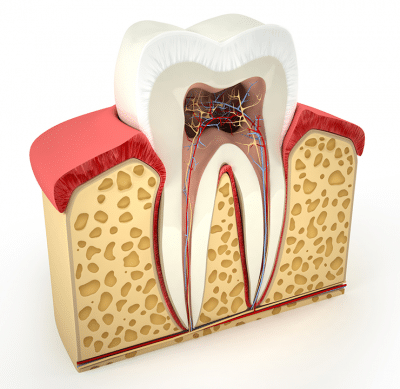 The words “root canal” are enough to strike fear into the hearts of even those who usually feel comfortable at the dentist. But when pressed to explain what a root canal actually is, those same fearful people are often stumped. Why have we become so universally terrified at a procedure most of us know only by name? Today, we’ll tackle the myths and misconceptions that make root canals seem so scary — and figure out what a root canal actually is!
The words “root canal” are enough to strike fear into the hearts of even those who usually feel comfortable at the dentist. But when pressed to explain what a root canal actually is, those same fearful people are often stumped. Why have we become so universally terrified at a procedure most of us know only by name? Today, we’ll tackle the myths and misconceptions that make root canals seem so scary — and figure out what a root canal actually is!
What is a Root Canal?
To understand a root canal, you must first understand the structure of a tooth. Inside the layers of enamel and dentin, your teeth contain a soft, living interior called pulp. This pulp contains nerves and blood vessels.
When you have a cavity, bacteria from the mouth have started to eat into your enamel. If left untreated, that bacteria may be able to reach the interior of your tooth and infect the pulp. When this happens, the risks skyrocket. Infection in the pulp of the tooth can spread into your jaw, your blood, and even your brain. These kind of infections can be life-threatening.
This is where the root canal comes in: In this procedure, the infected pulp from inside your tooth is removed–including that from the canals in the tooth’s root. That’s why it’s called a “root canal,” although it’s more properly known as “root canal therapy” or an endodontic (meaning “inside the tooth”) procedure. Once material is removed, the empty space is filled with a new, inert material to support the tooth’s structure, and finally the tooth is protected with a durable crown that covers it entirely.
Root Canal Misconceptions
The root canal is a highly effective treatment, so it’s a shame that it’s gotten such a bad rap. Luckily, the myths about root canals are easy to debunk.
- Root canals are painful. This is the biggest and most enduring myth about root canals. With modern anesthetics and tools, a root canal is no more painful than getting a filling. In fact, an infected tooth is significantly more painful than the procedure to correct it!
- Root canals kill your tooth. Yes, a root canal replaces the living pulp inside your teeth… but there’s no reason to fear. The purpose of pulp in adult teeth is as a warning system for infection and damage. After your root canal and crown placement, your tooth is adequately defended, and that warning system is unnecessary.
- Root canals cause cancer. This myth is a little more off-the-wall, but it is a surprisingly widely held belief anyway: Thanks to one century-old, since-discredited study, some people believe root canals increase your risk of cancer. Don’t worry; there’s not a single scrap of scientific evidence to support that.
- It’s better to simply pull the tooth. While removing the infected tooth is certainly an option, it isn’t necessarily a better option. Leaving that gap in your smile can actually negatively impact your oral health, and if you’re afraid of the procedure for a root canal, the procedure for a dental implant will probably seem equally scary.
If you think you might have a tooth infection in Sydney, call (02) 9686 7375 or contact us online to make an appointment.

